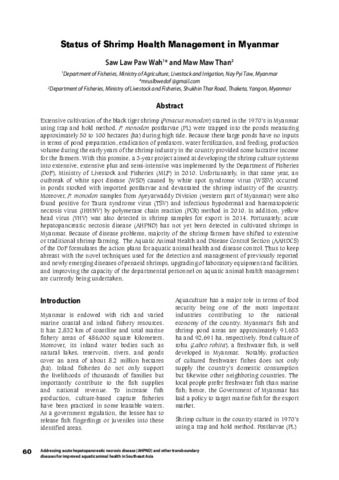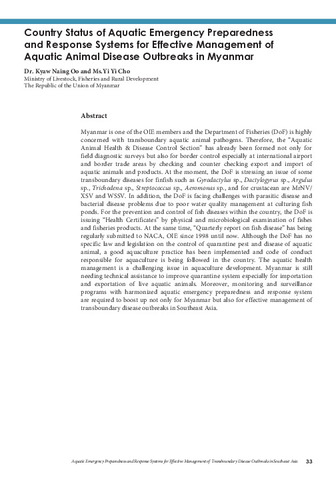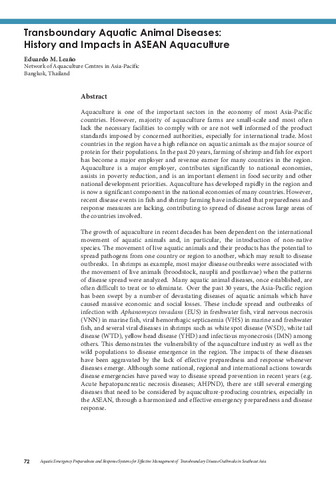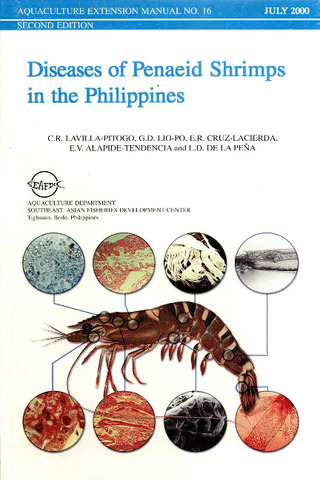Status of shrimp health management in Myanmar
Share
抄録
Extensive cultivation of the black tiger shrimp (Penaeus monodon) started in the 1970 s in Myanmar using trap and hold method. P. monodon postlarvae (PL) were trapped into the ponds measuring approximately 50 to 100 hectares (ha) during high tide. Because these large ponds have no inputs in terms of pond preparation, eradication of predators, water fertilization, and feeding, production volume during the early years of the shrimp industry in the country provided some lucrative income for the farmers. With this promise, a 3-year project aimed at developing the shrimp culture systems into extensive, extensive plus and semi-intensive was implemented by the Department of Fisheries (DoF), Ministry of Livestock and Fisheries (MLF) in 2010. Unfortunately, in that same year, an outbreak of white spot disease (WSD) caused by white spot syndrome virus (WSSV) occurred in ponds stocked with imported postlarvae and devastated the shrimp industry of the country. Moreover, P. monodon samples from Ayeyarwaddy Division (western part of Myanmar) were also found positive for Taura syndrome virus (TSV) and infectious hypodermal and haematopoietic necrosis virus (IHHNV) by polymerase chain reaction (PCR) method in 2010. In addition, yellow head virus (YHV) was also detected in shrimp samples for export in 2014. Fortunately, acute hepatopancreatic necrosis disease (AHPND) has not yet been detected in cultivated shrimps in Myanmar. Because of disease problems, majority of the shrimp farmers have shifted to extensive or traditional shrimp farming. The Aquatic Animal Health and Disease Control Section (AAHDCS) of the DoF formulates the action plans for aquatic animal health and disease control. Thus to keep abreast with the novel techniques used for the detection and management of previously reported and newly emerging diseases of penaeid shrimps, upgrading of laboratory equipment and facilities, and improving the capacity of the departmental personnel on aquatic animal health management are currently being undertaken.
Suggested Citation
Wah, S. L. P., & Than, M. M. (2016). Status of shrimp health management in Myanmar. In R. V. Pakingking Jr., E. G. T. de Jesus-Ayson, & B. O. Acosta (Eds.), Addressing Acute Hepatopancreatic Necrosis Disease (AHPND) and Other Transboundary Diseases for Improved Aquatic Animal Health in Southeast Asia: Proceedings of the ASEAN Regional Technical Consultation on EMS/AHPND and Other Transboundary Diseases for Improved Aquatic Animal Health in Southeast Asia, 22-24 February 2016, Makati City, Philippines (pp. 60-64). Tigbauan, Iloilo, Philippines: Aquaculture Department, Southeast Asian Fisheries Development Center.
主題
Taxonomic term
Related items
Showing items related by title, author, creator and subject.
-
Country status of aquatic emergency preparedness and response systems for effective management of aquatic animal disease outbreaks in Myanmar
Oo, Kyaw Naing; Cho, Yi Yi (Aquaculture Department, Southeast Asian Fisheries Development Center, 2019)Myanmar is one of the OIE members and the Department of Fisheries (DoF) is highly concerned with transboundary aquatic animal pathogens. Therefore, the Aquatic Animal Health & Disease Control Section has already been ... -
Transboundary aquatic animal diseases: History and impacts in ASEAN aquaculture
Leaño, Eduardo M. (Aquaculture Department, Southeast Asian Fisheries Development Center, 2019)Aquaculture is one of the important sectors in the economy of most Asia-Pacific countries. However, majority of aquaculture farms are small-scale and most often lack the necessary facilities to comply with or are not well ... -
Diseases of penaeid shrimps in the Philippines
Lavilla-Pitogo, Celia R.; Lio-Po, Gilda D.; Cruz-Lacierda, Erlinda R.; Tendencia, Eleonor; de la Peña, Leobert D. (Aquaculture Department, Southeast Asian Fisheries Development Center, 2000)The manual provides information on the diseases that affect the 3 major species of shrimps cultured in the Philippines: Penaeus monodon, P. merguiensis and P. indicus. It includes the common name of the disease, causative ...






